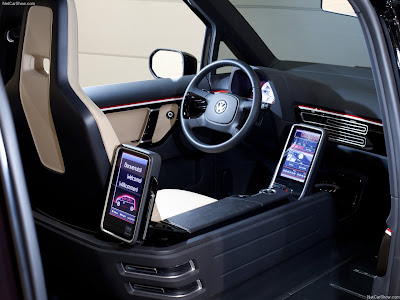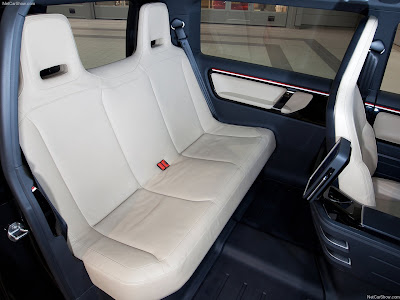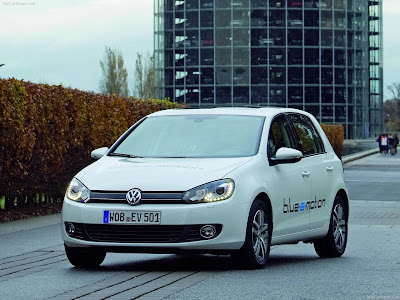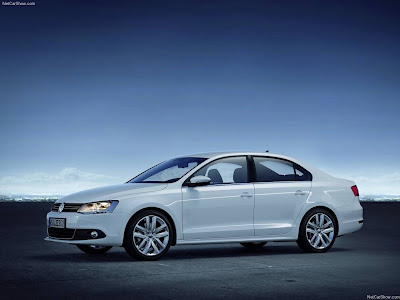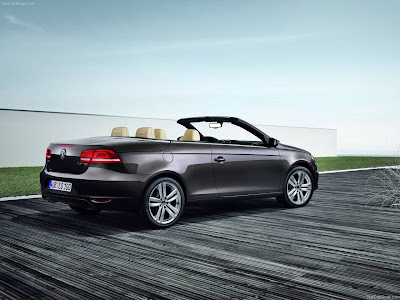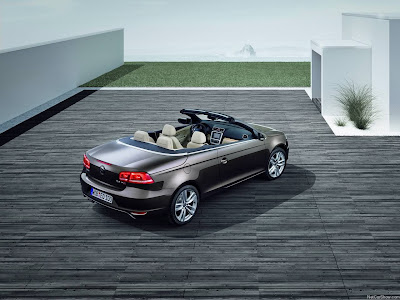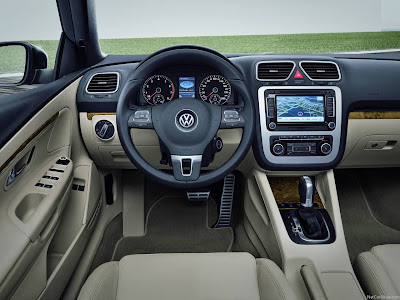








The Volkswagen Passat represents one of the very great success stories in automotive history, with over 15 million cars sold since the VW Passat was first launched in 1973. It is now available in over 100 countries across the globe. At the 2010 Mondial de l'Automobile in Paris (October 2-17), Volkswagen is presenting the world premiere of an entirely new Passat - as a saloon and an estate car simultaneously. The seventh generation of this bestseller will be available in initial European markets starting as soon as mid-November.
To the point - upper class flair in a mid-class car
The fifth and sixth Volkswagen Passat generations had already left conventional class boundaries behind and bridged a path to the next higher segment with their high-end features. The seventh generation VW Passat emphatically continues this trend. A completely new styling configuration was created; its front-end styling follows that of the Phaeton which was restyled mid-year. It simultaneously guides the Volkswagen Passat's independent design into the future. Without leaving the mid-class in terms of pricing, the Passat approaches the top segments even more powerfully with its upgraded comfort, convenience, quality and safety properties as well as in its assistance systems. In fact, the Volkswagen Passat - available in Trendline, Comfortline and Highline equipment levels - now offers more value thanks to its optimised features. For example, standard equipment on all turbodiesel models of the base Trendline version now includes the energy-saving Stop/Start system and battery regeneration. All other petrol and natural gas engines have a battery regeneration system as well. For the smallest petrol engine, battery regeneration and the Stop/Start system are available as options.
Volkswagen Passat Estate (2011)
Up to 18 percent improved fuel economy: As is usual for a Volkswagen, the new Passat also sets standards in sustainability. All ten engines (77 kW / 105 PS through 220 kW / 300 PS) are more fuel efficient - up to 18 percent more. The "smallest" and yet torque-strong turbodiesel (1.6 TDI with 105 PS and 250 Nm) now consumes just 4.2 l/100 km; that is equivalent to 109 g/km CO2. Meanwhile, downsizing and technologies such as the Stop/Start system contribute to extraordinary fuel efficiency in the petrol-powered versions. Pioneering here is the 1.4 TSI (90 kW / 122 PS); in the BlueMotion Technology version, it only consumes 5.8 l/100 km. The equivalent CO2 value is 138 g/km.
New safety features: Volkswagen is making genuine progress in the area of safety. The previous model already attained an impressive five stars in Euro-NCAP crash testing. The new model takes safety to a new level with features such as an automatic City emergency braking function and, on Comfortline models and above, a standard fatigue detection function. As a component of the optional automatic ACC adaptive cruise control system, in worst case scenarios the emergency braking function reacts independently at speeds below 30 km/h. So, it can help prevent frontal collisions. The fatigue detection system, which Volkswagen is introducing for the first time in this class, is continually active; it detects reduced driver concentration and warns the driver with an acoustic signal; a visual message also appears in the instrument cluster recommending that the driver should take a break from driving.
Another new feature on the Volkswagen Passat: the continually active masked main beam headlights known as Dynamic Light Assist; this is the same system as the one first introduced on the new Touareg. Dynamic Light Assist - an option offered in conjunction with bi-xenon headlights - enables continual use of the main beam headlights while driving. Via a camera, the system detects oncoming traffic and cars driving ahead and automatically masks only those lighting areas relevant to glare. The results: improved illumination of the carriageway in nearly all situations. The VW Passat is the first car in its class to have this system. For vehicles with conventional halogen headlights, a simpler version of automatic main beam control is available: Light Assist. A camera is also used here, e.g. to detect oncoming traffic. But the system switches over completely between main beam and dipped beam. As soon as there is no more oncoming traffic, the main beam is reactivated.
The XDS electronic transverse differential lock - first introduced on the Golf GTI - improves traction in bends. Along with Lane Assist (lane keeping assistant), which was also available in the previous model, there will now also be a Side Assist function, which uses flashing LEDs in the door mirrors to call the driver's attention to vehicles located laterally to the rear or next to the Volkswagen Passat or a vehicle approaching quickly from the rear. A new, direct measuring tyre pressure monitoring system also signals potential loss of tyre pressure - individually for each wheel. The pressures of all tyres may also be displayed in the instrument cluster.
Innovative convenience systems: Other new assistance systems are essentially convenience oriented, and they significantly simplify everyday driving. They include Easy Open: If the new VW Passat saloon is equipped with Keyless Access (automatic locking and engine starting system), a specific foot motion behind the vehicle is sufficient to cause the boot lid to open. Anyone who has stood next to a car with both hands full knows know helpful a function like Easy Open can be. Naturally, the boot lid only opens for someone who is carrying the proper RF identification fob for the Passat. The human-machine interface here is a sensor located in the bumper area.
Also new in the Volkswagen Passat: The rear seat system that can be unlatched from the bootspace, a towbar that can be made to swivel out at the press of a button and side windows in noise-dampening compound safety glass. As in the new Sharan, Park Assist II will now also be offered on the Passat; this system not only can steer into parking spaces parallel to the carriageway; it can also find its way into parking spaces perpendicular to it. Last but not least, the Volkswagen Passat's RNS 510 navigation system detects speed limit signs by camera and sends them to the touchscreen in the centre console.
Exterior: Styling & Dimensions
Volkswagen is visualising the model series' quality and precision more appreciably than ever in the new VW Passat. Straight lines, cleanly sculpted surfaces and dynamic proportions characterise the styling of the seventh generation car. Styling takes a great leap forward in the bestseller. The results: traditional class boundaries are once again shaken.
Front end: After the Phaeton, presented in the summer of 2010, Volkswagen is introducing the second model, the new Volkswagen Passat, whose front section is highlighted by a grille with four crossmembers; the height of the grille is approximately in line with the headlights. While a comparatively narrow radiator grille with two crossmembers marks the styling of models beneath the Passat and Phaeton, as well as the vans, Head of Design for the Volkswagen Group Walter de Silva and Head of Design for the Volkswagen Brand Klaus Bischoff deliberately chose this distinguishing feature on the radiator grille to highlight the status of higher positioned vehicles.
The entirely new front-end design gives the Volkswagen Passat - now 1,820 mm wide and 4,769 mm (Estate: 4,771 mm) long - an even more dominant look. Although the car has not grown in width, it has a greater presence and more visual dynamism. The heights of the two body versions also remained constant (saloon: 1,474 mm; Estate: 1,519 mm).
The dominant expression of the VW Passat is reinforced by its new dual-reflector headlights with optional bi-xenon light source and its LED daytime running lights. Each daytime running light consists of 15 LEDs. Beneath the lines formed by the headlights and grille is the body-coloured bumper section. The next level down sports another air intake framed by chrome-plated fins - as stylised elements similar to the wing tips of commercial aircraft. The very low profile fog lights are integrated here. On the Highline equipment line, another chrome trim strip at the centre of the air intake joins the fins. At the lowest level, there is the front spoiler. As on motorsport cars, it is designed as a so-called splitter. From the Comfortline equipment level, a chrome trim strip is also applied here.
Side profile: The front end blends into the side profile over the side contour of the V-shaped bonnet, in the style of the Phaeton, and the car's distinctive wing panel lines. Noticeable here are the significantly crisper lower and (new) upper character lines. These two lines now structure the height of the Passat and give it a lower profile and a more powerful image. In one clean stroke, the upper character line joins the highest point of the headlights with the window line up to the C-pillar. Beneath this is the second character line; it runs from the side sections of the headlights to the rear lights that extend into the side profile. In the sill area, a black (Trendline) or chrome (Comfortline and Highline) trim strip upgrades the lateral surfaces between the flared wheel housings; this trim strip is continued in the front and rear sections. The side profile, with its new door mirror design, is also characterised by a very fluid sweep from the roof section to the rear.
Rear: The significantly reduced wedge shape compared to the previous model along with the new line styling in particular give the rear section a lighter and more elegant appearance.
This makes the rear of the saloon appear lower, and the end surfaces of both body versions are wider. Very distinctive here are the rear lights that now wrap around into the wings. There are two lighting versions. The top version is in LED technology and has a night design in the shape of an M, similar to the implementation on the Phaeton. Beneath this, starting with the Comfortline the rear is framed by a chrome trim strip here too. In the estate car bumper, it runs right across the full width of the car; on the saloon it is split by the licence plate frame that is situated lower on the car.
Interior: Styling, Colour and Trim
Like the exterior, the new Passat also sports an extensively upgraded interior. A new seating concept was developed, and the seats were completely redesigned with head restraints that now have horizontal adjustment like those on the Touareg, and there are new door trim panels. The latter can be equipped with elegant ambience lighting. Different decorative trim configurations are used in the door panels, depending on the equipment line. Another option: a new climate seat is available with active ventilation and massage function for driver and front passenger.
Redesigned in many aspects are the surfaces and details of the dashboard and the centre console with their intuitive displays and controls, as well as chrome inserts around the air vents. In the process, Volkswagen has fundamentally upgraded the composition and quality of the materials used, bridging over to the next higher market segment. Interior designers have placed an analogue clock at the centre of the instrument cluster - as you would expect to find in the luxury class. The layout of switches in the lower section of the centre console was also completely restructured, i.e. around the gearshift lever of the 6 or 7-speed gearbox. Now arranged there are a switch for the electronic parking brake and, with the Keyless Access option, an engine start button.
An especially bright interior ambience is created when the panoramic sunroof is ordered; this new option was developed for the estate car. The Volkswagen Passat is available in different interior colour combinations. The classic "Black" colour emphasises the Volkswagen's sports appeal. "Natural Brown" produces an elegant and pleasant interior. The third colour, "Desert Beige," is borrowed from nature, and gives the Volkswagen Passat an even more spacious appearance. Two-tone seat patterns are available in the optional colour combinations "Natural Brown / Desert Beige" (Highline) and, as part of the sport pack, in "Truffle / Black" (Comfortline and Highline).
Efficiency: Engines & Gearboxes
Volkswagen is offering a selection of ten direct-injection engines with four valves per cylinder in the new Passat. Four of them are classic high-tech petrol engines that output 90 kW / 122 PS (1.4 TSI), 118 kW / 160 PS (1.8 TSI), 155 kW / 211 PS (2.0 TSI) and 220 kW / 300 PS (V6). The top engine has six cylinders; all of the other petrol engines are charged four-cylinder engines. Also charged is the 110 kW / 150 PS engine (1.4 EcoFuel) that is configured for natural gas. Another derivative of the 1.4 TSI is the MultiFuel engine with 118 kW / 160 PS designed for use with up to 85 percent ethanol fuel.
Four turbodiesel engines are being offered with three power outputs; the four-cylinder engines produce 77 kW / 105 PS (1.6 TDI), 103 kW / 140 PS (2.0 TDI and 2.0 BlueTDI) as well as 125 kW / 170 PS (2.0 TDI). With the exception of the 105 PS TDI, any of the engines of the new VW Passat may be combined with a dual-clutch gearbox (DSG); with the 3.6 V6, this automatic gearbox is standard.
Petrol - three four-cylinder TSIs and one V6: Fuel consumption values are impressive. Setting the pace among the petrol engines is the Volkswagen Passat 1.4 TSI with optional BlueMotion Technology. It outputs 90 kW / 122 PS and consumes 5.8 l/100 km (equivalent to 138 g/km CO2).
While the groundbreaking previous model exhibited a nearly identical low fuel consumption figure, fuel economy improvements in the more powerful engines are even more dramatic. Consider the Passat 1.8 TSI with 118 PS: Here the development team reduced the engine's combined fuel consumption from 7.4 to 6.9 l/100 km; this resulted in a CO2 value of 160 g/km. No less significant is the reduced fuel consumption of the powerful TSI, now 211 PS instead of 200 PS; it has a combined fuel consumption of 7.2 l/100, which is 0.6 litre less than on the previous model. Accordingly, CO2 emissions were reduced from 183 to 169 g/km. The combined fuel consumption of the top version - the Volkswagen Passat V6 with 300 PS and all-wheel drive - also fell to 9.2 l/100 km (previously 9.8 litres). The new CO2 emissions value is 215 g/km.
Natural gas - the EcoFuel engine: One of the lowest emitting models of the medium class is the VW Passat EcoFuel; in the new version, a combined fuel consumption value of 6.6 m3 natural gas per 100 km was measured; this has equivalent CO2 emissions of just 117 g/km, and fuel consumption was reduced by 0.4 m3. Thanks to twincharging by turbo- and supercharger (twincharger), the Passat EcoFuel is one of the top-performing natural gas vehicles in the world.
Ethanol - the MultiFuel engine: Specially developed for use in Sweden and Norway, and based on the twincharged 1.4 TSI, is the 118 kW / 160 PS MultiFuel Twincharger. This engine in the programme can be powered by petrol fuel with up to 85 percent ethanol content.
Diesel - four TDI engines: The most fuel-efficient version of the new Volkswagen Passat is the 1.6 TDI BlueMotion with 105 PS. In the previous version, this engine already delivered impressively low fuel consumption values. Measures introduced to enhance aerodynamics, further internal engine refinements and technologies such as the Stop/Start system and battery regeneration have reduced fuel consumption to 4.2 l/100 km in the new Passat BlueMotion (saloon); this is equivalent to a CO2 value of 109 g/km. By comparison: on the previous model, the figures were 4.4 litres and 114 g/km. Fuel consumption was also reduced in the 140 PS VW Passat 2.0 TDI BlueMotion Technology; 4.5 litres (119 g/km CO2) nearly matches the values of the 105 PS BlueMotion model of the previous VW Passat generation.
Extreme progress was made on the Volkswagen Passat 2.0 BlueTDI and the Passat 2.0 TDI with 170 PS. For the particularly low-emitting Passat 2.0 BlueTDI (Euro 6 emissions standard) with SCR catalytic converter and 140 PS (previously 143 PS), fuel consumption was reduced by 0.6 l/100 km to just 4.6 litres (122 g/km CO2). The combined fuel consumption of the 170 PS Passat 2.0 TDI is 4.7 l/100 km (123 g/km) - 0.9 litre less than on the previous model. Values for the Volkswagen Passat Estate - and this applies to all engine options - are at about the same level - and superior to the competition - with just minimal deviations of +/- 0.1 litre.





